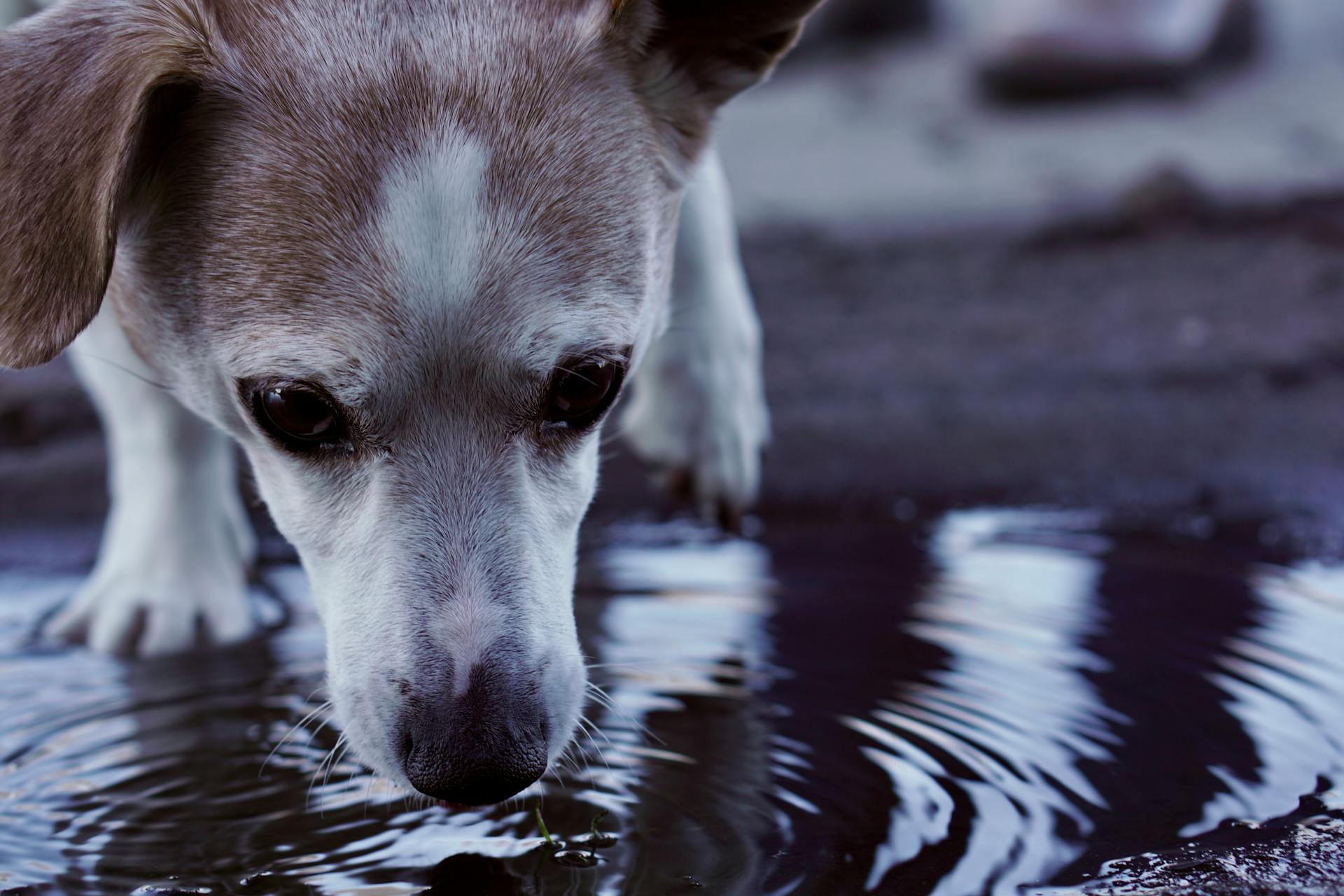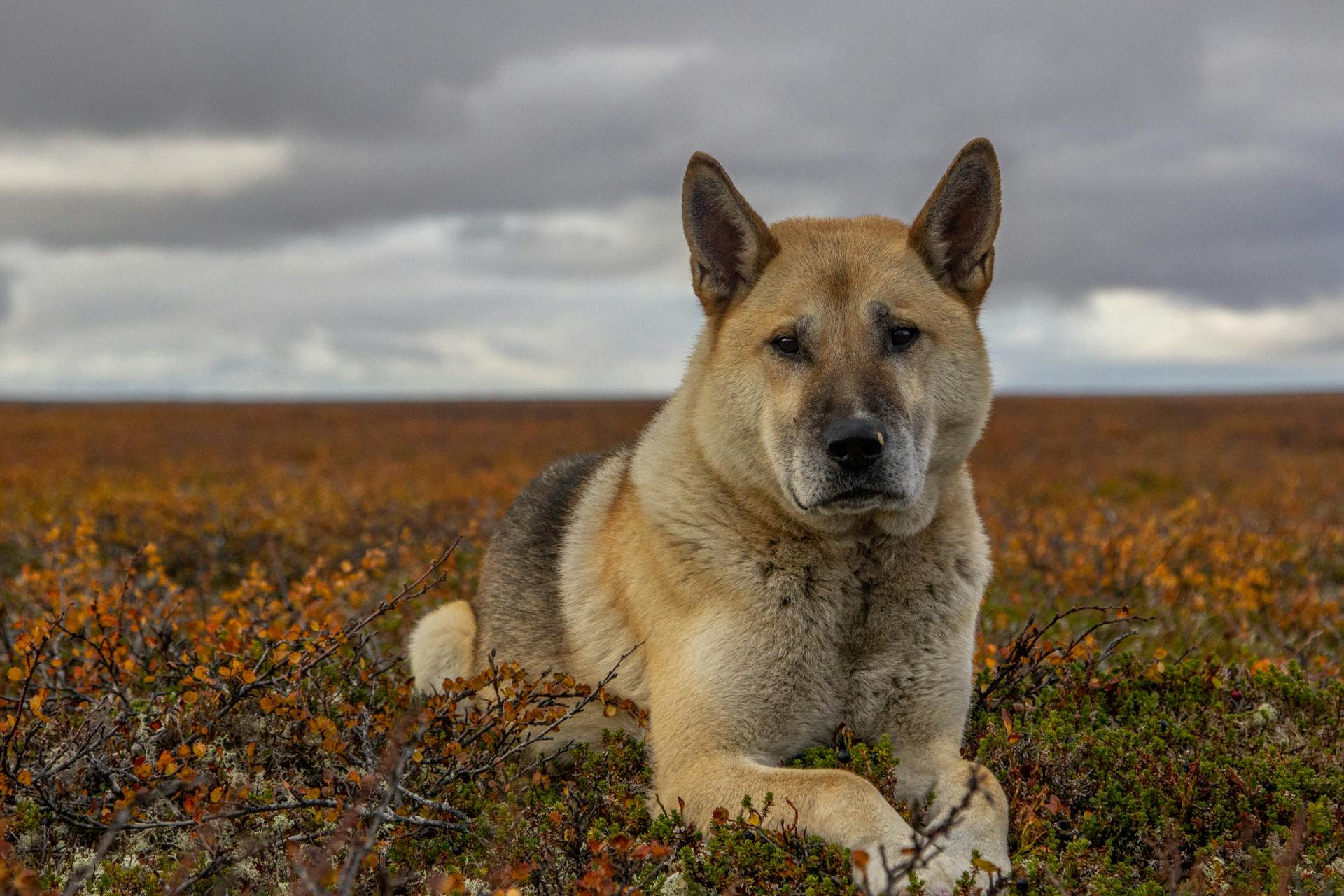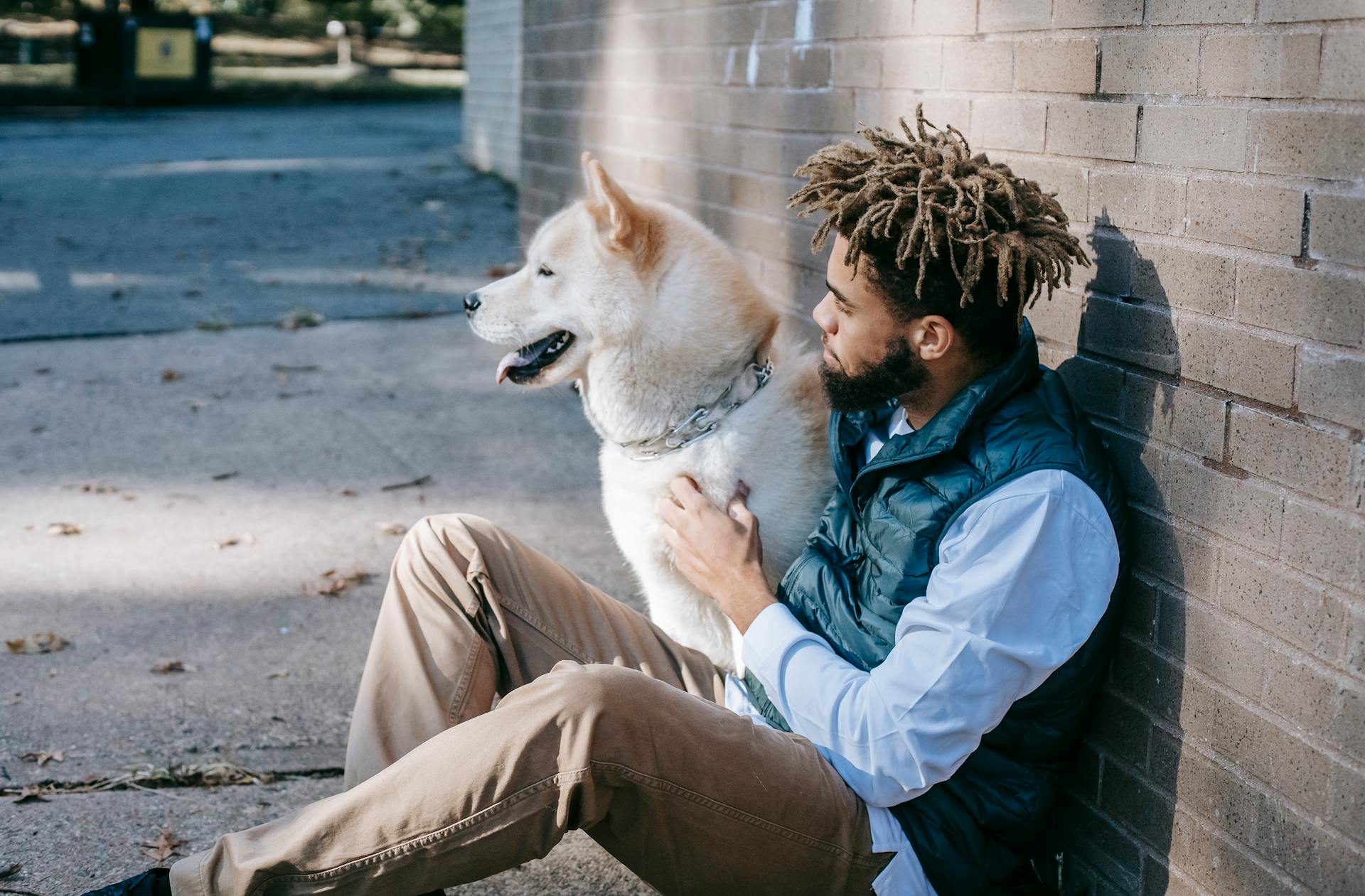
American Akitas are known to be fiercely loyal and protective of their families, but this loyalty can sometimes turn into aggression. They have a strong prey drive and may attack small animals, especially if they're not socialized properly.
In fact, a study found that 75% of American Akitas that exhibited aggression were not socialized to other animals before 16 weeks of age. This highlights the importance of early socialization in preventing aggression.
American Akitas are also prone to fear-based aggression, which can be triggered by loud noises, strangers, or other environmental stimuli. This type of aggression can be particularly challenging to address, as it's often rooted in the dog's deep-seated fears.
If you're considering bringing an American Akita into your family, it's essential to be aware of these potential aggression risks and take steps to mitigate them.
Causes and Prevention
American Akita aggression can stem from a complex interplay of internal and external factors. Every dog is an individual, and their triggers and responses to stress can vary greatly.
Fear can be a major contributor to aggression in American Akitas, particularly if they have a history of abuse or neglect. A frightened dog might lash out as a defensive mechanism, feeling threatened by unfamiliar situations, people, or animals.
Pain or illness can also lead to aggression in American Akitas, as they may become irritable and more prone to snapping or biting due to physical discomfort. This could be due to injuries, medical conditions, or even dental issues.
Frustration can build in American Akitas when their routine is disrupted or they're unable to fulfill their natural instincts, leading to aggressive outbursts. Consistent positive reinforcement training can help prevent this by providing clear expectations and promoting good behavior.
A lack of socialization is another key factor in American Akita aggression, as it can make them overly protective of their owners and lead to aggressive behavior in public. Early socialization and positive reinforcement training are crucial for puppies to develop proper social skills and emotional regulation.
To prevent aggression in American Akitas, it's essential to create a safe and loving environment, provide ample exercise and mental stimulation, and practice consistent positive reinforcement training. By doing so, you can help your American Akita blossom into a well-adjusted, happy individual.
Here are some common reasons why American Akitas might exhibit aggression:
- Fear
- Pain or illness
- Frustration
- Possessiveness
- Lack of socialization
Causes of Dog Aggression
Dog aggression is a complex issue that can stem from a variety of internal and external factors. Fear is a common reason why dogs might growl, snap, or bite, particularly in dogs with a history of abuse or neglect.
A frightened dog might lash out as a defensive mechanism, feeling threatened by unfamiliar situations, people, or animals. This can be particularly common in dogs with a history of abuse or neglect.
Pain or illness can also contribute to aggression in dogs, causing them to become irritable and more prone to biting or snapping.
Dogs thrive on routine and clear expectations, so frustration can build when these are disrupted, leading to aggressive outbursts.
Some dogs might become possessive of food, toys, or even their owners, exhibiting aggression towards anyone who they perceive as a threat.
A lack of socialization can also lead to aggression in dogs, making them overly protective of their owners and leading to aggressive behavior in public.
Here are some common causes of dog aggression:
- Fear
- Pain or illness
- Frustration
- Possessiveness
- Lack of socialization
Remember, every dog is an individual, and their triggers and responses to stress can vary greatly.
Unmasking the Myths

Aggression is not inherent to any specific breed, and certain breeds may be predisposed to physical traits or historical purposes, but that doesn't automatically equate to aggression.
Early socialization and consistent training by a firm owner are critical for any dog to learn normal interactions from threatening situations, regardless of breed.
Most individual dogs of so-called aggressive breeds can make good pets with proper training, but some dogs' aggressive tendencies may never be fully overcome.
You can't judge a dog's potential for aggression based on its breed alone, and individual personalities vary widely, even within breeds.
Determined owners who invest time and effort into intensive training and establishing clear rules and boundaries can help any dog become a wonderful pet, regardless of breed.
Readers also liked: Crate Training Separation Anxiety
Akita Aggression
Akita aggression can stem from a variety of factors, including fear, pain or illness, frustration, possessiveness, and lack of socialization. These factors can cause an Akita to lash out in aggressive behavior.
Akitas are known to be wary of strangers, making them great watchdogs, but this can also develop into bad social skills with other dogs and people. This breed specifically responds well to positive reinforcement training.
Some Akitas may exhibit aggression due to their high prey drive and dominant nature. They can be extremely affectionate towards their family, but standoffish and territorial when it comes to strangers.
Early socialization and consistent training are crucial to ensure an Akita learns to distinguish normal interactions from threatening situations. Most individual dogs of so-called aggressive breeds can make good pets with proper training.
Akitas may never be fully overcome if their aggressive tendencies are deeply ingrained. They may not integrate well into certain households, especially if they're not provided with the necessary discipline and attention.
To address Akita aggression, it's essential to create a safe and loving environment, provide ample exercise and mental stimulation, and practice consistent positive reinforcement training.
If this caught your attention, see: Dog Fear Aggression Training
Liability and Laws
An owner can be held liable for their dog's actions under the One Bite Rule, which states that dog owners can be held liable for their dog's aggressive acts only after the owner has been given reason to know that the dog has aggressive tendencies.
In many places, Akitas are listed as a dangerous breed, which affects the ability of their owners to find rentals, carry liability insurance, or even own the dogs.
If the One Bite Rule does not apply, the owner may be held liable under a negligent handling cause of action, which holds owners responsible for harm done by their animals if they are negligent in failing to prevent the harm.
The Restatement of Torts 518 states that an owner who possesses an animal they have no reason to be abnormally dangerous is subject to liability for harm done by the animal if they are negligent in failing to prevent the harm.
Check this out: Why Do Chihuahuas Bite so Much
Holding Owner Liable for Dog Bite
If the One Bite Rule doesn't apply, an owner may be held liable under a negligent handling cause of action.
The Restatement of Torts 518 states that an owner who possesses an animal they have no reason to believe is abnormally dangerous is subject to liability for harm done by the animal if they are negligent in failing to prevent the harm.
If a dog is injured or recently gave birth, the owner should keep strangers away because the dog may be extra sensitive or more protective than usual.
Laws and Insurance
Akitas are often considered a high-risk breed, which can affect their owners' ability to find rentals. In many places, Akitas are listed as a dangerous breed.
Some municipalities have rules governing the ownership of aggressive dogs. Apartment complexes may refuse to rent to people who own Akitas. Insurance policies may not cover dog bites caused by a so-called aggressive breed like an Akita.
Even if you've never had any problems with your Akita, the law and regulators might still see your dog as aggressive.
Will Animal Control Take My Dog?
If animal control is contacted about your dog, they'll likely take your dog for a 10-day quarantine period to monitor for signs of rabies.
This quarantine period is standard procedure, and in most cases, you'll be able to pick up your dog after 10 days unless animal control has reason to believe your dog is a danger to others.
If animal control does need to take further action, there will be a court hearing to determine whether your dog meets the requirements for a "dangerous dog" case.
The outcome of this hearing will determine what happens next, but it's essential to remember that animal control's primary concern is public safety.
Risk and Control
Akitas have a unique jaw structure that makes their bites particularly concerning. Their scissor-shaped jaw gives them a significant amount of bite force, making it difficult to pry their mouths open to release a bite.
A study conducted by Animals 24-7 found some alarming statistics on Akita bites. Here are the numbers:
- Bites resulting in bodily harm: 70
- Maimings: 52
- Deaths: 8
This highlights the importance of being able to control your Akita, especially around children. In fact, Akitas bite children at a 2:1 rate, with 44 child bites compared to 22 adult bites.
Risk

Akitas have a unique jaw structure that makes them a high-risk breed for dog bites. Their scissor-shaped jaw gives them an incredible amount of bite force, which can be devastating.
The risk of Akita bites is not just theoretical - a study found 70 bites resulting in bodily harm, 52 maimings, and 8 deaths. These statistics are a sobering reminder of the potential consequences of an Akita bite.
Children are disproportionately affected by Akita bites, with a 2:1 ratio of child bites to adult bites. This is likely due to the fact that children are more vulnerable and less able to defend themselves.
The study also found that children between the ages of 5 and 9 are the largest age group to suffer from dog bites. This is a critical age group, as children are learning to navigate the world and may not have the skills to avoid dog bites.
Here are the statistics from the study:
- Bites resulting in bodily harm: 70
- Maimings: 52
- Deaths: 8
Control

Control is crucial when it comes to owning a dog, especially a large breed like an Akita. Full-grown Akitas can stand 26 inches tall and weigh 130 lbs.
Even the best-behaved dogs can have a moment where they slip up. You need to be able to control your dog in those situations. Whether that is through stern voice commands or physically being able to restrain them, control is critically important.
Frequently Asked Questions
What is the temper of an American Akita?
American Akitas are naturally protective and loyal, forming strong bonds with their family but often being cautious around strangers. They can make great companions for those who understand their unique temperament.
What are the disadvantages of American Akitas?
American Akitas can be high-maintenance pets due to their shedding, need for constant entertainment, and potential health risks. They also require experienced owners who can manage their strong prey drive, aggression, and wariness of strangers.
Featured Images: pexels.com


